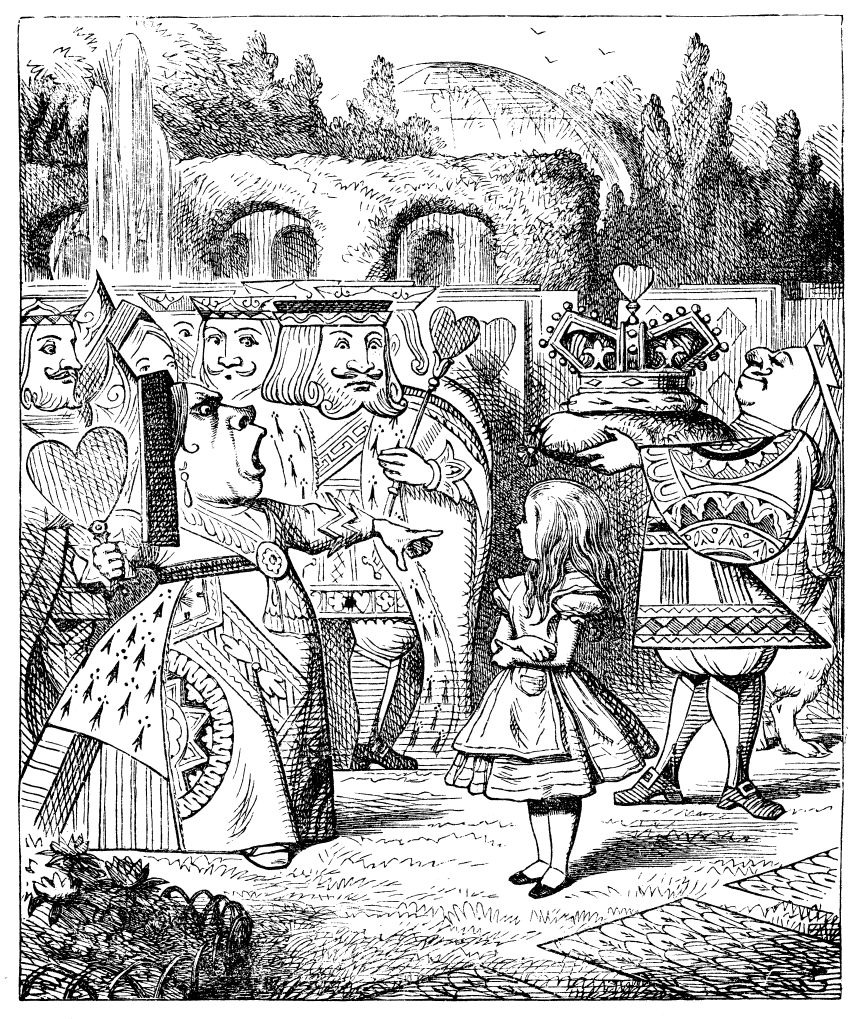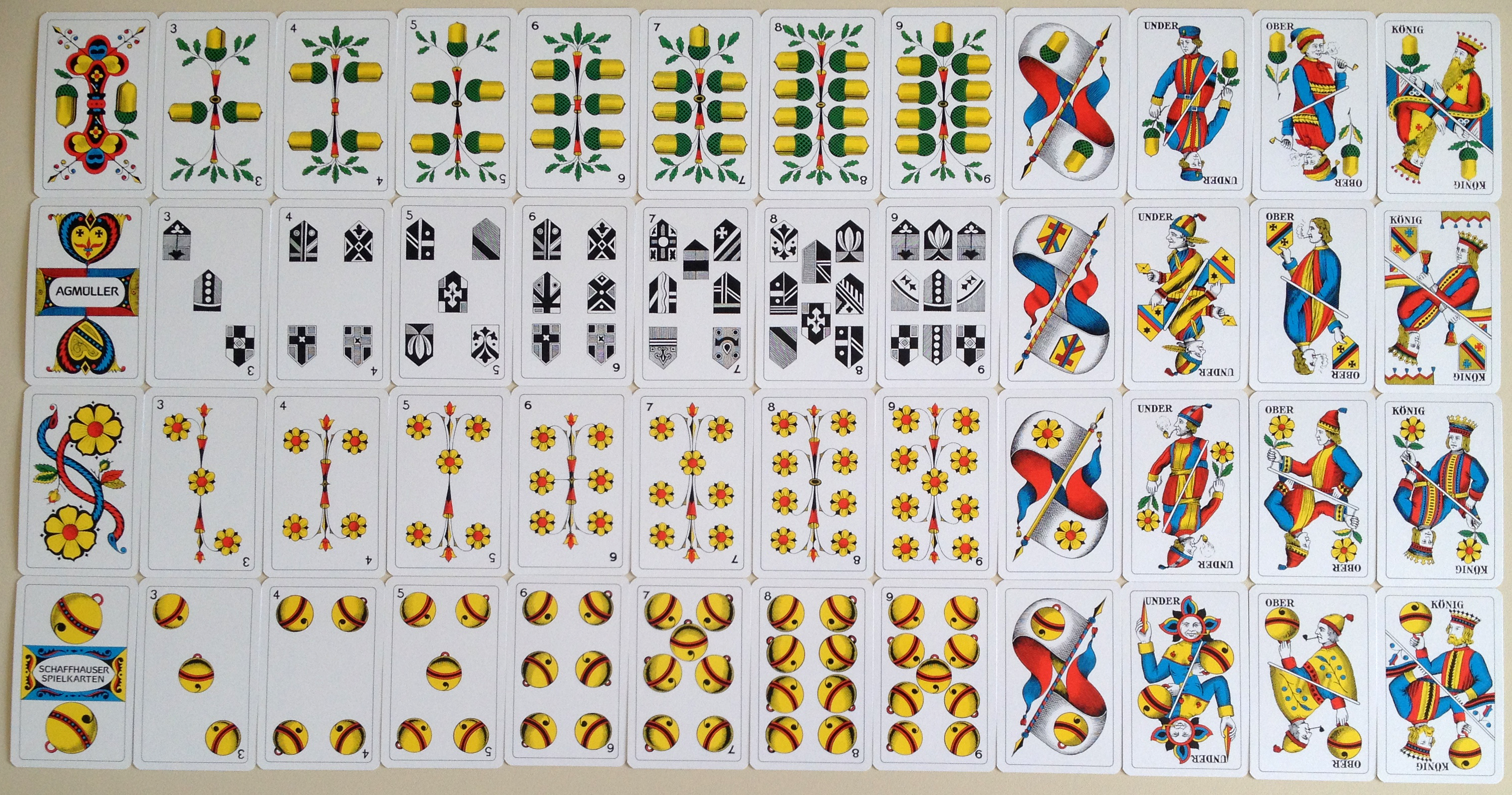|
Stuttgart Pack
The Stuttgart pack or Stuttgart Cards () is one of the most valuable collections of the Landesmuseum Württemberg. It is a hunting-themed deck of playing cards painted on gilded pasteboard dating to around 1430.Wintle, Adam''Stuttgart pack, c.1430''at the World of Playing Cards. Retrieved 9 September 2016.Pollett, Andreaat Andy's Playing Cards. Retrieved 9 September 2016. They are thus among the earliest surviving packs of playing cards. Description 49 of the original 52 cards survive. The cards are divided into four suits of thirteen ranks. The suits of stags and hounds are led by female face cards (Queen, female Ober, female Unter) while the suits of ducks and falcons are led by men (King, male Ober, male Unter). The 10 of each suit is represented with a banner like in Swiss playing cards. The backs are uniformly painted with red lead. Facsimiles A limited edition facsimile of the cards was produced as a boxed set with accompanying booklet in German and English by an unkno ... [...More Info...] [...Related Items...] OR: [Wikipedia] [Google] [Baidu] |
Landesmuseum Württemberg
The Landesmuseum Württemberg (Württemberg State Museum) is the main historical museum of the Württemberg part of the German state of Baden-Württemberg. It emerged from the 16th-century “Kunstkammer” ( Cabinet of art and curiosities) of the dukes, later kings, of Württemberg who resided in Stuttgart. As a museum it was founded in 1862 by King William I. Collections in Stuttgart and Waldenbuch The museum's main location is the Old Castle in Stuttgart. The nearby granary and the cellar of the New Castle also contain parts of the collections as well as Waldenbuch Castle outside of Stuttgart. The collections are grouped into eight divisions: * Schausammlung ''LegendäreMeisterWerke'' (Legendary Masterpieces) ** archeology: Paleolithic, Neolithic, Bronze Age, Iron Age, antiquity, Romans in Württemberg, early Middle Ages ** history of art and cultural history: Württemberg crown jewels, medieval art, modern glass painting * Schausammlung ''Wahre Schätze ... [...More Info...] [...Related Items...] OR: [Wikipedia] [Google] [Baidu] |
Playing Card
A playing card is a piece of specially prepared card stock, heavy paper, thin cardboard, plastic-coated paper, cotton-paper blend, or thin plastic that is marked with distinguishing motifs. Often the front (face) and back of each card has a finish to make handling easier. They are most commonly used for playing card games, and are also used in magic tricks, cardistry, card throwing, and card houses; cards may also be collected. Playing cards are typically palm-sized for convenient handling, and usually are sold together in a set as a deck of cards or pack of cards. The most common type of playing card in the West is the French-suited, standard 52-card pack, of which the most widespread design is the English pattern, followed by the Belgian-Genoese pattern. However, many countries use other, traditional types of playing card, including those that are German, Italian, Spanish and Swiss-suited. Tarot cards (also known locally as ''Tarocks'' or ''tarocchi'') are an ol ... [...More Info...] [...Related Items...] OR: [Wikipedia] [Google] [Baidu] |
Face Card
In a deck of playing cards, the term face card (US) or court card (British and US), and sometimes royalty, is generally used to describe a card that depicts a person as opposed to the pip cards. In a standard 52-card pack of the English pattern, these cards are the King (playing card), King, Queen (playing card), Queen and Jack (playing card), Jack. The term picture card is also common, but that term sometimes includes the Aces. After the American innovation of corner-indices, the idea of "pictured" cards from tarot trumps was used to replace all 52 cards from the standard deck with pictures, art, or photography in some souvenir packs featuring a wide variety of subjects (animals, scenery, cartoons, pin-ups, vehicles, etc.) that may garner interest with collectors. In the standard packs of non-English speaking regions, the face or court cards may be different. For example, in Italian-suited cards, Italian- and Spanish-suited packs there is a Knight (playing card), Knight or Ca ... [...More Info...] [...Related Items...] OR: [Wikipedia] [Google] [Baidu] |
Queen (playing Card)
The queen is a playing card with a picture of a queen on it. In many European languages, the king and queen begin with the same letter so the latter is often called ''dame'' (lady) or variations thereof. In French playing cards, the usual rank of a queen is between the king and the jack. In tarot decks, it outranks the knight which in turn outranks the jack. In the Spanish deck and some Italian decks, the Queen does not exist and the Knight appears in them instead, with the same role and value. In several card games, including the middle eastern Trex and French Barbu, the queen is a major card to avoid taking, with each queen taken inflicting a penalty on the player. Similarly, in Hearts, the queen of spades is to be avoided, and is called a variety of unsavoury names. In the Paris pattern, each court card is identified as a particular historical or mythological personage as follows: Image:Queen of spades fr.svg, Pallas Image:Queen of hearts fr.svg, Judith, Biblical ... [...More Info...] [...Related Items...] OR: [Wikipedia] [Google] [Baidu] |
Ober (playing Card)
The Ober, formerly Obermann, in Austrian also called the Manderl, is the court card in the German and Swiss styles of playing cards that corresponds in rank to the Queen in French packs. The name ''Ober'' (lit.: "over") is an abbreviation of the former name for these cards, ''Obermann'', which meant something like 'superior' or 'lord'. Van der Linde argues that the King, Ober and Unter in a pack of German cards represented the military ranks of general, officer (''Oberofficier'') and sergeant (''Unterofficier''), while the pip cards represented the common soldier. The figure depicted on an Ober is usually a nobleman or officer. It is distinguished from the lowest court card, the Unter (lit. "under", formerly ''Untermann'' or "vassal", "subject", "subordinate"), by the figure's suit sign located in the upper range of the card. In the Württemberg pattern the Ober appears on horseback, as they were inspired by Cego packs whose face cards included a Knight or Cavalier as we ... [...More Info...] [...Related Items...] OR: [Wikipedia] [Google] [Baidu] |
Unter (playing Card)
The Unter, formerly Untermann, nicknamed the Wenzel, Wenz or Bauer, and (in Swiss) also called the Under, is the face card, court card in German playing cards, German and Swiss playing cards, Swiss-suited playing cards that corresponds to the Jack (playing card), Jack in French playing cards, French packs. The name ''Unter'' (lit.: "under") is an abbreviation of the former name for these cards, ''Untermann'', which meant something like 'subordinate' or 'vassal'. Van der Linde argues that the King, Ober and Unter in a pack of German cards represented the military ranks of general, officer (''Oberofficier'') and sergeant (''Unterofficier''), while the pip cards represented the common soldier. The Unter is distinguished from the ''Ober (playing card), Ober'' (lit. "over", formerly ''Obermann'') by the fact that the suit sign is located in the lower part of the image on single-headed cards or in the centre of the image on double-headed cards. Unters or ''Untermänner'' were described ... [...More Info...] [...Related Items...] OR: [Wikipedia] [Google] [Baidu] |
King (playing Card)
The king is a playing card with a picture of a king displayed on it. The king is usually the highest-ranking face card. In the French version of playing cards and tarot decks, the king immediately outranks the queen. In Italian and Spanish playing cards, the king immediately outranks the knight. In German and Swiss playing cards, the king immediately outranks the '' Ober''. In some games, the king is the highest-ranked card; in others, the Ace is higher. Aces began outranking kings around 1500 with Trappola being the earliest known game in which the aces were highest in all four suits. In the ace–ten family of games such as pinochle and Schnapsen, both the ace and the 10 rank higher than the king. History The king card is the oldest and most universal court card. It most likely originated in Persian Ganjifeh where kings are depicted as seated on thrones and outranking the viceroy cards which are mounted on horses. Playing cards were transmitted to Italy and Spain via ... [...More Info...] [...Related Items...] OR: [Wikipedia] [Google] [Baidu] |
Banner (playing Card)
The ''Banner'' is a playing card used in Swiss-suited cards and which historically formed part of the standard 36- or 48-card German-suited packs. It is equivalent to a 10, being ranked between a 9 and an '' Unter'' (or ''Under'' in Swiss German). Name In German, ' means “flag” or “banner” and is pronounced . It is grammatically neuter and its plural is the same: Banner. Historically it was also spelt ''Panier''. Characteristics In German-speaking Switzerland, to the east of the Brünig-Napf-Reuss line (the German-speaking part of Switzerland corresponding to the centre and east of the country), the most popular card deck is a pack of 36 cards with the Swiss suit symbols of Acorns, Bells, Roses and Shields and numbered as follows: 6, 7, 8, 9, 10 or Banner, Unter, Ober, King and Deuce. While the pip cards 6 to 9 display a number of suit symbols corresponding to the number of the card, the 10 follows a different scheme. It has only one example of the suit symbol, ... [...More Info...] [...Related Items...] OR: [Wikipedia] [Google] [Baidu] |
Swiss Playing Cards
Parts of Swiss German speaking Switzerland have their own deck of playing cards referred to as Swiss-suited playing cards or Swiss-suited cards. They are mostly used for Jass, the "national card game" of Switzerland. The deck is related to the various German playing cards. Within Switzerland, these decks are called German or Swiss German cards. Distribution of the Swiss deck is roughly east of the Brünig-Napf-Reuss line, in Schaffhausen, St. Gallen (and in adjacent Liechtenstein), Appenzell, Thurgau, Glarus, Zürich, all of Central Switzerland and the eastern part of Aargau. Cards The suits are as follows: The most common deck has 36 cards, nine of each suit. The card values are, in ascending order, :six, seven, eight, nine, ''Banner'' (ten), '' Under'', '' Ober'', ''König'', '' As''. For the purposes of ''Jass'', the numbered cards (six to nine) have no point value, the banner has a value of ten points, the picture-cards Under, Ober, König have values of two, three ... [...More Info...] [...Related Items...] OR: [Wikipedia] [Google] [Baidu] |
Ambraser Hofjagdspiel
The Ambraser Hofjagdspiel (Court Hunting Pack of Ambras; sometimes the Ambras falconer cards or the Courtly Hunt Cards) is a pack of cards painted around 1440–1445 and attributed to the engraver Konrad Witz from Basel, Switzerland. It originally consisted of fifty-six cards from which only 54 survive, all distributed in four suits, falcons, lures, hounds and herons, symbols related to hunting. Each suit contained ten pip cards with the 10s being represented by a banner like many old German playing cards and modern Swiss playing cards. There are four face cards per suit: the Unter, Ober, Queen, and King. It was found in a collection at the Ambras Castle, in Innsbruck, Austria, in the 16th century, and now figures as a precious item in the collection of cards of the Kunsthistorisches Museum (Museum of Art History) in Vienna. Facsimile A facsimile of the pack was produced as a boxed set in 1995 by Piatnik Wiener Spielkartenfabrik Ferd. Piatnik & Söhne, commonly referre ... [...More Info...] [...Related Items...] OR: [Wikipedia] [Google] [Baidu] |
Flemish Hunting Deck
The Flemish Hunting Deck, also known as the Cloisters set of fifty-two playing cards and Hofjaren Jachtpakket (in Dutch), is a set of fifty-two playing cards owned by the Metropolitan Museum of Art, New York, United States. It is significant in that it is the only complete set of ordinary playing cards from the fifteenth century. Estimate ranges of manufacture are between 1470 and 1480. The rounded-ended cards consist of suits represented by hunting equipment along with face cards which represent exaggerated fashion from the 15th century. The cards are hand-drawn and painted on pasteboard, with highlights of gold and silver, in the contemporary technique for illuminated manuscripts. History The set was most likely made in the Southern Netherlands, in Flanders specifically. Research was conducted into the cards by Sotheby's fashion experts, looking into the details of the fashion of the face cards. The research concluded that the type of jacket and haircut, worn above the ears, ... [...More Info...] [...Related Items...] OR: [Wikipedia] [Google] [Baidu] |









